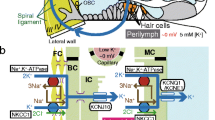Abstract
To determine whether any differences exist in potassium circulation between the scala vestibuli and scala tympani, we recorded the change in K+ activity in both scalae of the guinea pig cochlea at the basal and third turns, using a double-barrelled, K+-sensitive microelectrode after perfusion with artificial perilymph containing 20 mM KCl and 130 mM NaCl. K+ activity increased immediately after the start of perfusion and decreased after its completion. The rates of decrease of K+ activities were approximately 1.0 mEq/l per min in the scala vestibuli of the basal and third turns, also 1.0 mEq/l per min in the scala tympani of the basal turn, and approximately 0.5 mEq/l per min in the scala tympani of the third turn. The rate of decrease of K+ activity in the scala tympani was significantly slower in the third turn than in the basal turn. Blockage of the cochlear aqueduct depressed the rate of decrease of K+ activity in the scala tympani more in the basal turn than in the third turn. These results suggest that there is a difference in potassium circulation between the scala vestibuli and scala tympani, and that the cochlear aqueduct plays an important role in potassium circulation in the perilymph of the scala tympani.
Similar content being viewed by others
References
Altman F, Waltner JG (1950) New investigation on the physiology of the labyrinthine fluids. Laryngoscope 60:727–739
Housley GD, Ashmore JF (1992) Ionic currents of outer hair cells isolated from the guinea-pig cochlea. J Physiol (Lond) 448:72–98
Huangfu M, Komune S, Snow JB (1982) Dynamics of the flow of perilymph in the cochlea of the guinea pig. Arch Otolaryngol 108:535–538
Jako G, Weille FL, Palmer PE, Irwin JW (1959) An experimental study of the dynamic circulation of the labyrinthine fluids. Ann Otol Rhinol Laryngol 68:733–739
Kimura RS, Schuknecht HF, Ota CY (1974) Blockage of the cochlear aqueduct. Acta Otolaryngol (Stockh) 77:1–12
Kirikae I, Nomura Y, Nagakura M, Matsuba Y, Sugiura S (1961) A consideration on the circulation of the perilymph. Ann Otol Rhinol Laryngol 70:337–343
Komune S, Snow JB (1982) Nature of the endocochlear dc potential in kanamycin-poisoned guinea pigs. Arch Otolaryngol 108:334–338
Komune S, Nakagawa T, Hisashi K, Kimitsuki T, Uemura T (1993) Movement of monovalent ions across the membranes of marginal cells of the stria vascularis in the guinea pig cochlea. ORL 55:61–67
Konishi T, Hamrick PE, Walsh PJ (1978) Ion transport in guinea pig cochlea. I. Potassium and sodium transport. Acta Otolaryngol (Stockh) 86:22–34
Moscovitch DH, Gannon RP, Laszlo CA (1973) Perilymph displacement by cerebrospinal fluid in the cochlea. Ann Otol Rhinol Laryngol 82:53–61
Ohyama K, Salt AN, Thalmann R (1988) Volume flow rate of perilymph in the guinea-pig cochlea. Hear Res 35:119–129
Salt AN, Stopp PE (1979) The effect of cerebrospinal fluid pressure on perilymphatic flow in the opened cochlea. Acta Otolaryngol (Stockh) 88:198–202
Sando I, Wook RP, Masuda Y, Hemenway WG (1971) Perilymphatic communication routes in guinea pig cochlea. Ann Otol Rhinol Laryngol 80:826–834
Sterkers O, Ferrary E, Saumon G, Amiel C (1987) Na and nonelectrolyte entry into inner ear fluids of the rat. Am J Physiol 253:F50-F58
Sterkers O, Ferrary E, Amiel C (1988) Production of inner ear fluids. Physiol Rev 64:1083–1128
Tonndorf J, Duvall AJ, Reneau JP (1962) Permeability of intracochlear membranes to various vital stains. Ann Otol Rhinol Laryngol 71:801–841
Toriya R, Arima T, Kuraoka A, Uemura T (1991) Ultrastructure of the guinea pig cochlear aqueduct. An electron microscopic study of decalcified temporal bones. Acta Otolaryngol (Stockh) 111:699–706
Author information
Authors and Affiliations
Rights and permissions
About this article
Cite this article
Hisashi, K., Komune, S., Kimitsuki, T. et al. Potassium circulation in the perilymph of guinea pig cochlea. Eur Arch Otorhinolaryngol 251 (Suppl 1), S48–S52 (1994). https://doi.org/10.1007/BF02565219
Received:
Issue Date:
DOI: https://doi.org/10.1007/BF02565219




